**Tip:** Check it now. Verestro Paytool demo application is available [here.](https://paytool.verestro.dev/demo/)
#### How to connect with us? The Paytool solution provides three independent integration paths.**Note:** It is required that you have an account in Acquirer's system which will settle your transactions. For more informations please contact our Sale Department. We are suggesting to use [Fenige](https://www.fenige.com/) as this is our partner acquiring institution and we are fully integrated with this Acquirer
##### Web integration The first way is that after opening a payment session, your browser should redirect the payer to the Paytool application or open it in iframe. Verestro will be fully responsible for the execution of transactions and handling 3D Secure authentication. In the application the payer can see the transaction metadata and chooses payment method he wish to pay. All required payment data is transferred to the Verestro Paytool backend over the Verestro internal network. ##### Iframe integration Another method of integration with Paytool is to embed our solution on your store’s website in the form of an iframe. In this case, the payer is not redirected to our payment gateway page. Instead, the gateway is loaded directly within your application. Here, the payer selects a payment method from the list of options displayed by Paytool. However, the payment confirmation takes place within your application, since your app provides the **“Pay”** button. This implementation is designed to prevent situations in which the payer completes a payment within Paytool while the merchant’s application also offers alternative external payment methods that could still process a payment for the same product. ##### API integration The last option of the integration is to use communication server to server. In this case, after opening a payment session, you can carry out the payment process using the API methods provided by us. Your server should then integrate with our API, which allows you to make payments and carry out the 3D Secure process. Verestro does not provide any frontend application in this way of integration. # Overview This document provides a description of functionalities offered by Verestro Paytool. Our solution supports various payment methods such as Google Pay™, Apple Pay, Blik and Debit/Credit Card in the form of the payment gateway. In addition, you can decide which payment methods should be enabled. Simply put, you may decide that, for example, you want Verestro Paytool to provide payment via Google Pay but payment via Debit/Credit Card should be disabled. In such a situation, the end user will see the Google Pay as the availabe payment method in the Verestro Paytool payment form, but the Debit/Credit Card payment method will not appear at all. Transaction process mainly takes place on Verestro's side. This means that you are completely relieved of responsibility for processing the transaction and/or performing 3D Secure authentication. The only action that the you must do is to provide metadata of the transaction, which includes order number, description, amount, currency and some optional parameters.**Important!** Note that if you require the settlement of the transaction by an Acquirer to which Verestro is not integrated there will be required new integration between Verestro and the new Acquirer. You should provide the specification of the new Acquirer which will allow us to perform integration.
## Abbreviations In this chapter there are abbreviations and acronyms used in the document listed in below table.| **Abbreviation** | **Description** |
| ACQ | Acquiring Institution / Acquirer |
| ACS | Access Control Server |
| SDK | Software Development Kit |
| PSP | Payment Service Provider |
| OS | Operative System |
| Mid | Merchant Identifier |
| PCI DSS | Payment Card Industry Data Security Standard |
| PAN | Permanent Account Number |
| CVC | Card Verification Code |
| 3DS | 3-D Secure |
| DCC | Dynamic currency conversion |
| **Name** | **Description** |
| Customer/Merchant | Institution which uses Verestro products. This institution decides which payment method should be available in the solution and how transaction should be processed. |
| End user/payer | The entity which uses Paytool solution to pay for ordered good from Customer. It is root of entity tree. End user is an owner of the wallet/card and he decides to pay for the purchase using Paytool solution, selecting it from the list of payment methods available in the Customer application. |
| Payment service provider | The entity which provides a payment services for external Customers who do not have direct integration with acquirers or are not PSI DSS compilent. From the perspective of he Paytool application, Verestro is the PSP. |
| Card | Card belongs to the user. If user intends to pay with the Paytool solution using plain card payment method, then has to insert required card's data to the appropriate fields shared by the Paytool solution payment form. Card data will not be stored in the Verestro system. They will be provided to Acquirer. |
| Card payment token | It is a numerical value in the form of a PAN number. It shows a given card from Google Pay or Apple Pay wallet. The card payment token replaces the card number and is delivered by Google Pay/Apple Pay to Verestro if the end user selects one of the two above mentioned payment options. Verestro passes this value to Acquirer for the payment to be made. |
| Authorization Method | The way of the authentication of the Google Pay™ card transaction. Verestro supports followed authorization methods: `PAN_ONLY` and `CRYPTOGRAM_3DS` if Customer's country belongs to the European Union. Authorization method is always provided in the Google Pay™ encrypted payload as `authMethod` parameter. |
| Gateway Id | Phrase/value that identifies a given Payment Service Provider in the Google Pay™ system. The Merchant provides gateway Id to Google Pay™ to obtain a card payment token. By provided gateway Id, Google Pay™ encrypts the card payment token with the appropriate public key. Verestro is defined by a gateway Id with the value `verestro` in Google Pay™ server. |
| Gateway Merchant Id | Unique Customer identifier assigned by Verestro during the onboarding process. This identifier is in the form of a `UUID`. Verestro understands and uses this to verify that the message was for the Customer that made the request. Customer passes it to Google Pay™. More information about the Gateway Merchant Id can be found in [Google Pay™ documentation.](https://developers.google.com/pay/api/processors/guides/implementation/understand-our-payload) |
| Acquirer | Institution that settles payments. Paytool communicates with the Acquirer to order the transaction and authenticate the card holder using the 3D Secure protocol. |
| MID | Merchant identifier. This entity is represending Customer in the Acquirer's system. Customer has to provide the mid information to enable mid configuration in the Verestro system. Required to process transactions and 3DS process via Verestro system. |
| Bank/Issuer | Card issuing institution. In the case of an e-commerce transaction, this entity is responsible for checking whether the cardholder's balance has the appropriate amount of funds to perform a given transaction, determining whether 3D secure authentication is necessary or simply checking whether the card is active. |
| Cardholder | This is the end user who pays for his purchases using one of the available payment options in Verestro Paytool. |
| PAN | It is 7-16 digits of the credit/debit card number. These digits contain the Permanent Account Number assigned by the bank to uniquely identify the account holder. It is necessary to provide it when end user wants to pay with a card for purchases via Verestro Paytool solution. |
| CVC | Card Verification Code. It is a type of security code protecting against fraud in remote payments. CVC is necessary to provide it when end user wants to pay with a card for purchases via Paytool solution. |
| Expiration date | It is a date of the card validity ending and contains two values – month/year - for example 01/28. Card will be valid to the last day of the month of the year showed on it. It is necessary to provide it when end user wants to pay with a card for purchases via Verestro Paytool solution. |
| 3DS | 3-D Secure is a method of authorization of transaction made without the physical use of a card, used by payment organization. The 3DS process in the Verestro Paytool solution is performed internally in the Verestro system which means the Customer is not responsible for end user authentication. |
| PCI DSS | It is a security standard used in environments where the data of payment cardholders is processed. The standard covers meticulous data processing control and protection of users against violations. |
| Dynamic currency conversion | Dynamic currency conversion is a process whereby the amount of a credit card transaction is converted to the currency of the card's country of issue. |
| Tokenization | A security measure where sensitive payment data, like credit card numbers, is replaced with a unique string of characters called a "token". |
| Card on file | Verestro PCI DSS cards storage. It allows for storing the card data of a given payer and using it in subsequent transactions without having to re-enter this data. |
**Note:** The `X-509 certificate` data will be signed during the [onboarding process](https://developer.verestro.com/books/merchant-paytool/page/onboarding).
### Redirect your payer The first integration path is to redirect your payer to the payment web view. This implementation model is more comprehensive because when redirecting the payer, you only need to provide us with transaction metadata and the payment session identifier. We are responsible for the rest of the payment process. Do not forget to initialize the payment session for the transaction before redirecting the payer to the Paytool web view. To initialize payment session use the `transaction initialization` method.**Tip:** We highly recommend using [Redirect your payer](https://developer.verestro.com/books/paytool/page/overview#bkmrk-redirect-your-payer) integration model because most of the processes and responsibilities are handled on our side and the integration process is very smooth.
**Info:** In this model we do not provide a frontend view.
**Note:** Unlike the other integration models, the `transaction initialization` method in this flow is executed **only after** the payer's data and payment instrument details have been successfully collected.
The last of the supported integration paths involves embedding Paytool directly into your application, which requires the use of a dedicated [SDK](https://paytool.verestro.com/docs/category/getting-started). The process begins with the backend requesting a list of the user's saved cards via the [`paymentMethods`](https://developer.verestro.com/books/paytool/page/paytool-external-api) endpoint. Depending on the response and the availability of the "Card on File" service, the initialized [SDK](https://paytool.verestro.com/docs/category/getting-started) displays either a list of available cards or a form for new card entry within a secure iframe. Once the user confirms their selection by clicking the "Pay" button, the application retrieves the data from the iframe using the `getFormState` method. Based on this information, the backend creates a payment session via the `transactionInitialization` endpoint to obtain a transaction identifier (`transactionId`). Finally, this identifier is passed to the SDK's `pay` method to authorize and finalize the payment process. \[Simplified sequence diagram from tech docs\]\\**Note:** If you intend to use Paytool iframe, ensure that strict domain whitelisting (e.g., Content Security Policy) is disabled in your application. This is necessary because the cardholder authentication process often requires loading HTML templates directly from the card-issuing bank. Since each bank operates on a unique domain, restrictive whitelisting may block these resources, preventing the user from completing the transaction.
**Important!** It is crucial to understand that in this integration model, the "**Pay**" button **must be a component of your application's UI**. The Paytool iframe does not render its own submission button. Your application is fully responsible for controlling the payment flow by listening for user events (like the "**Pay**" button click) and invoking the corresponding Paytool SDK methods at each step.
| Services that are the part of the Verestro Paytool Solution. |
| Services supporting the functionalities offered by Verestro Paytool Solution. |
| **Services that are the part of the Verestro Paytool Solution** | |
| **Component** | **Description** |
| Paytool API | A service with all methods required to complete the entire transaction process. The methods are called by Paytool Frontend App or by your API in the right order to make the entire payment and 3D Secure process. This service also communicates with the Verestro Acquirer Connector, which orders the execution of the transaction. The last and probably the most important element for which the Paytool API is responsible is opening a payment session and saving the transaction entities in the Verestro system. Another role of this component is to communicate between the Verestro system and the Acquirer's system. This service transfers transaction requests to the Acquirers and also informs if the 3D Secure authentication process is required. This component stores cards in our PCI DSS database in the case of Card on File payment method usage. |
| **Services supporting the functionalities offered by the Verestro Paytool Solution** | |
| **Component** | **Description** |
| Notification Service API | A service responsible for sending notifications to end users and Customers. Notifications to end user can be sent via e-mail. The Customer can receive [transaction postback](https://developer.verestro.com/books/paytool/page/paytool-external-api) via a specific URL he provided. |
| **Component** | **Description** |
| Paytool Frontend App | This is a frontend application hosted by Verestro. This is where you redirect the user when you are using the [Redirect your payer](https://developer.verestro.com/books/paytool/page/overview#bkmrk-redirect-your-payer) integration path. This service is intended to display transaction data to the end user, enable him to select a payment method and confirm payment. To perform the above actions, the Paytool Frontend App communicates directly with the Paytool API. This service does not participate in the payment process at all if you use the [Payment process via API](https://developer.verestro.com/books/paytool/page/overview#bkmrk-payment-process-via-) integration path. Alternatively you can open Paytool in iframe. |
| Paytool SDK |
| **Card type** |
| `MASTERCARD` |
| `VISA` |
| `MAESTRO` |
**Note:** We does not store any sensitive data such as PAN or CVC in our system. The obtained data are only required to be transferred to the Acquirer to perform transaction.
### Authorization Authorization of the Customer in the Paytool system is performed using mTLS. Information on how to generate a certificate and the details of the signing process are available in the [How to integrate](https://developer.verestro.com/books/paytool/page/paytool-external-api) section. Such authorization in Paytool application is intended to check whether the entity trying to execute the request is authorized to do so. If you have a merchant account in the Paytool system, each of your requests should be signed with the certificate x509. This allow us to check whether the action you have taken can be proceeded. We will also check whether your merchant account is associated with a given transaction, and therefore whether it can perform any actions in the context of this transaction # Use cases This chapter is mainly dedicated to the appearance of the application and a description of the individual paths that the end user will follow depending on the payment method he choosed. Each of the payment method available in Paytool application is described in a separate section. Additionally, every chapter contains diagrams depicting the entire transaction process per payment method.**Tip:** Check it now. Verestro Paytool demo application is available [here.](https://paytool.verestro.dev/demo/)
## Transaction initialization The first step of the each transaction always takes place in your application. Your application integrated with the Verestro Paytool solution should have exposed option allowing to pay using Paytool available in your application. Your backend should deliver the initial transaction data to the Paytool API to open new transaction session when your payer selects the Paytool as payment option. ### Redirect The first option of the integration is by redirecting the payer to our payment gateway, which lists all available payment options. When you request to create a payment session, the Paytool API responds with a transaction ID and a redirect URL. Simply redirect the user to this address to allow them to choose a payment method and finalize the transaction. The view of transaction initiatialization from the end user's perspective has been shown below. This view refers to the [Redirect your payer](https://developer.verestro.com/books/paytool/page/overview#bkmrk-redirect-your-payer) integration path:| [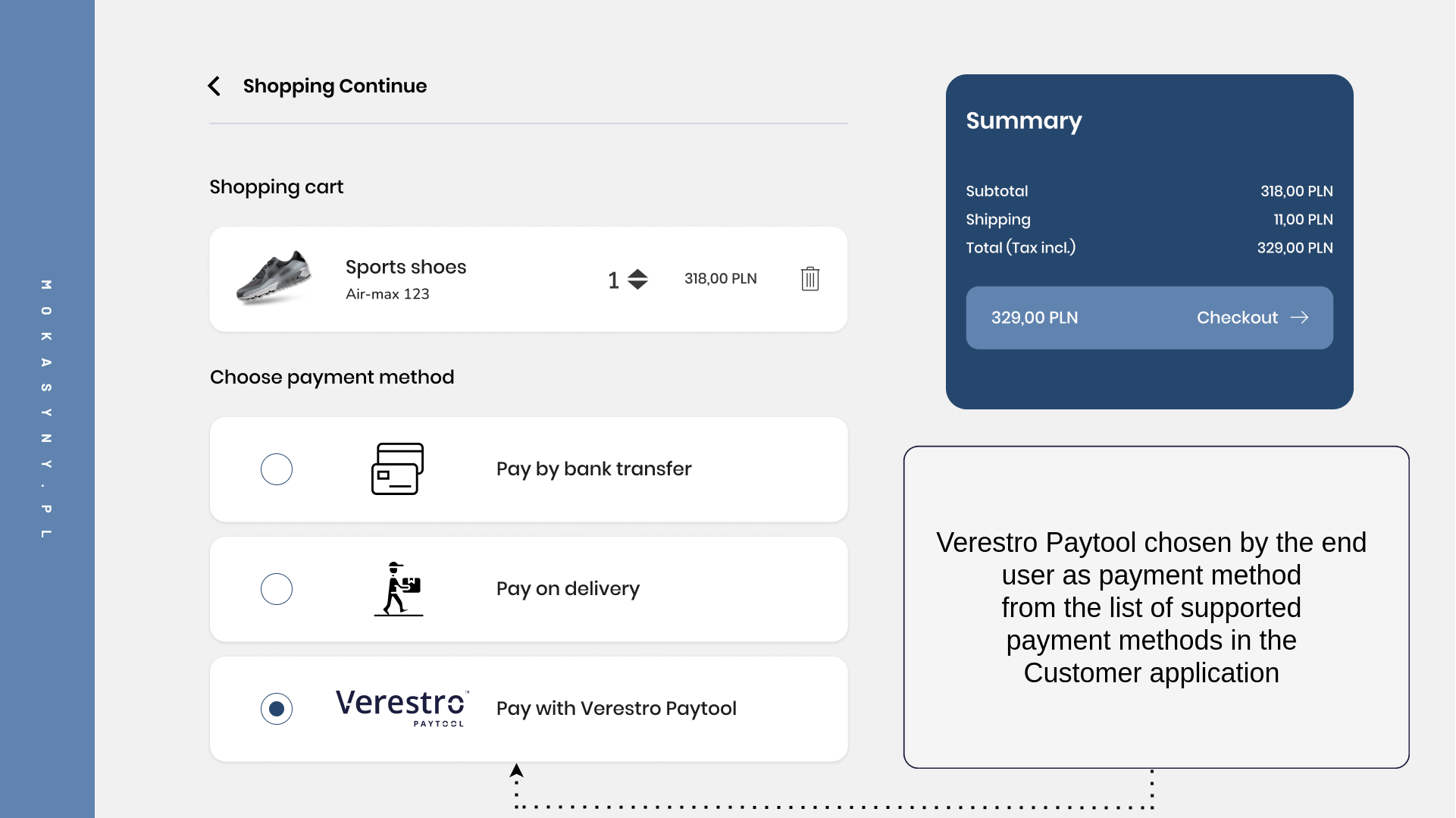](https://developer.verestro.com/uploads/images/gallery/2023-06/image-1687851731553.png) | [](https://developer.verestro.com/uploads/images/gallery/2025-12/image.png) |
**Tip:** In this implementation model your application makes a request to the [`transactionInitialization`](https://developer.verestro.com/books/paytool/page/paytool-external-api) method to create a payment session and then redirect your payer to the Paytool application. From this point on, are fully responsible for all other steps in the process such as execution of the transaction and [threeDs authentication](https://developer.verestro.com/books/paytool/page/use-cases#bkmrk-threeds).
**Important!** This part of the documentation is work in progress...
### Server to server An alternative path to carry out a transaction is a [Payment process via API](https://developer.verestro.com/books/paytool/page/overview#bkmrk-payment-process-via-) integration path. Paytool Frontend does not appear in this path. You make all requests directly from your server to the Paytool API methods we described in [technical integration guide](https://developer.verestro.com/books/paytool/page/how-to-integrate). Paytool API responds with transaction ID and you should use this transaction ID to execute a proper payment method choosed by your payer.**Note:** Some of the payment methods available in the Paytool frontend may not be available with an API to API connection.
| **Payment methods in Paytool** | **Redirect your payer (open Paytool in webview)** | **Payment in iframe (open Paytool iframe embed in your app)** | **Payment via API (call Paytool API methods)** |
| Google Pay™ | Available | Not yet available | Available |
| Apple Pay | Available | Not yet available | Not yet available |
| Blik | Available | Not yet available | Not yet available |
| Card & Card on file | Available | Available | Available |
**Note:** It is required that you have created account in the Acquirer's system which will settle your transactions. Verestro Paytool solution has been implemented so that it is possible to process transactions with the participation of various Acquirers. If you require the settlement of the transaction by a new Acquirer – to which we are not yet integrated – there will be required new integration between Verestro and the new Acquirer. You should provide a specification of the Acquirer API.
### Card The most common payment method available in our application is payment using plain card details. This payment method consists in providing a payment form in which the end user can enter his payment card details. The option to pay with plain card details is available at the button shown below: [](https://developer.verestro.com/uploads/images/gallery/2023-05/image-1685428055821.png) After clicking on the payment option using plain card details, the end user is redirected to the specially prepared payment form. Now he is able to provide the appropriate card details and clicks the **Pay** button at the bottom of the screen. At this point, the card details are encrypted and sent to the Paytool backend which requests Acquirer to process transaction. At this moment [threeDs authentication](https://developer.verestro.com/books/paytool/page/use-cases#bkmrk-threeds) process may be required. The payment process using plain card details from the end user's perpective has been shown below: [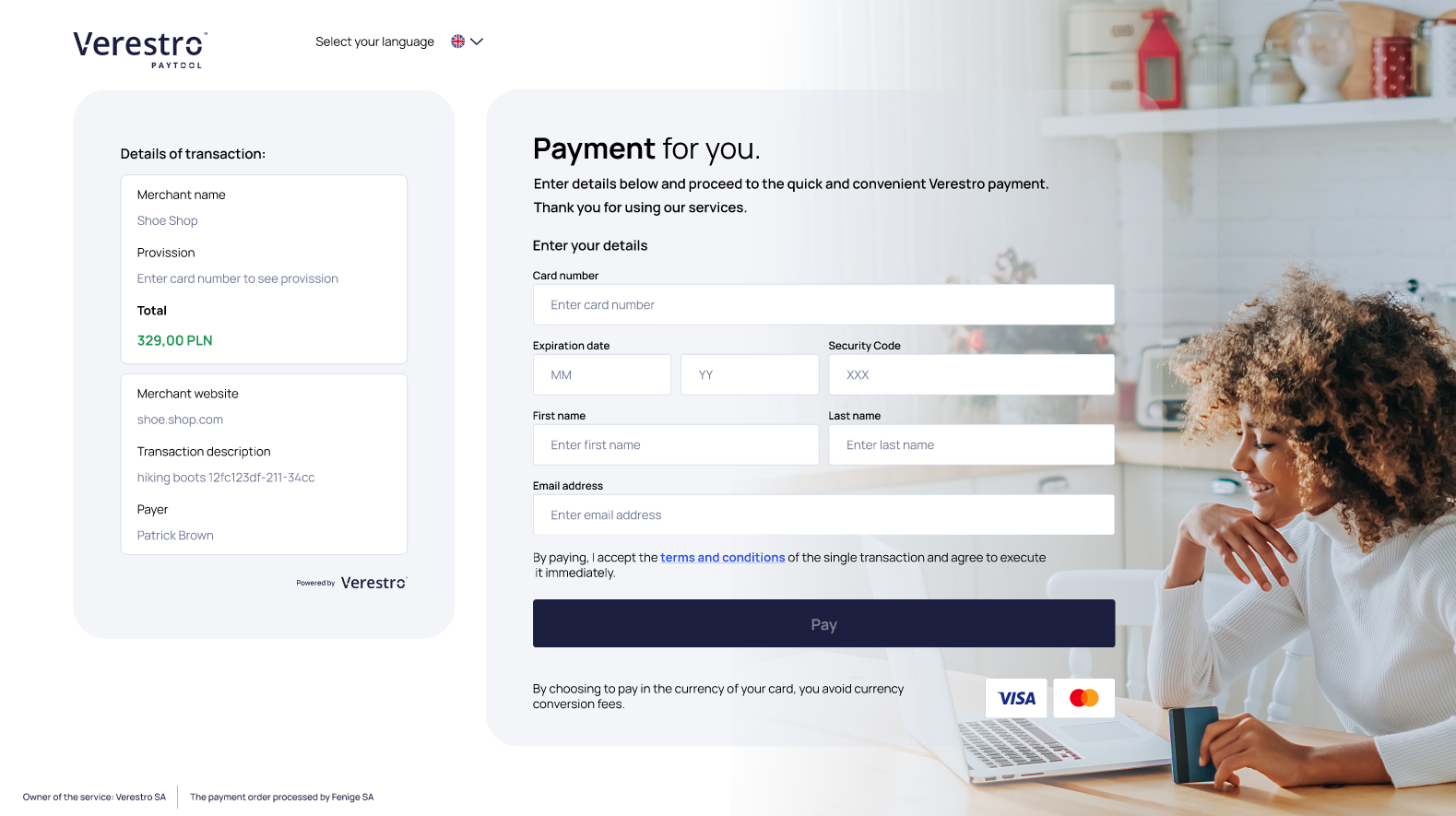](https://developer.verestro.com/uploads/images/gallery/2025-12/U7Aimage.png)| **Payer has no saved cards** | **Payer has saved cards** | **Payer has saved cards and provides new card** |
| In this scenario, the payer selects the card on file payment option without having any previously saved card. A form is immediately displayed, allowing them to enter the details of the card they wish to use. To save the card, the user must check the "**Save card**" checkbox. In this case, if the "**Save card**" option is selected, the card is automatically set as the default one, since it is the first card saved by this payer. After confirming the payment request, 3D Secure authentication is performed. To see more details of the current transaction, the user can click "**Expand**" button. [](https://developer.verestro.com/uploads/images/gallery/2025-08/new-card1.png) | In this flow, the payer selects the *card on file* payment option while already having a previously saved card in our system. Two options are displayed: pay with the saved card or use a new card. When choosing to pay with the saved card, 3D Secure authentication will be skipped. When selecting the option to use a new card (by clicking the **"Pay with new card"** button), a form for entering the new card details is displayed. To save the card, the **"Save card"** checkbox must be selected. Additionally, in this case, a **"Set as default"** checkbox is shown, allowing the user to set the new card as the default one. After confirming the payment request with newly added card, 3D Secure authentication is performed. [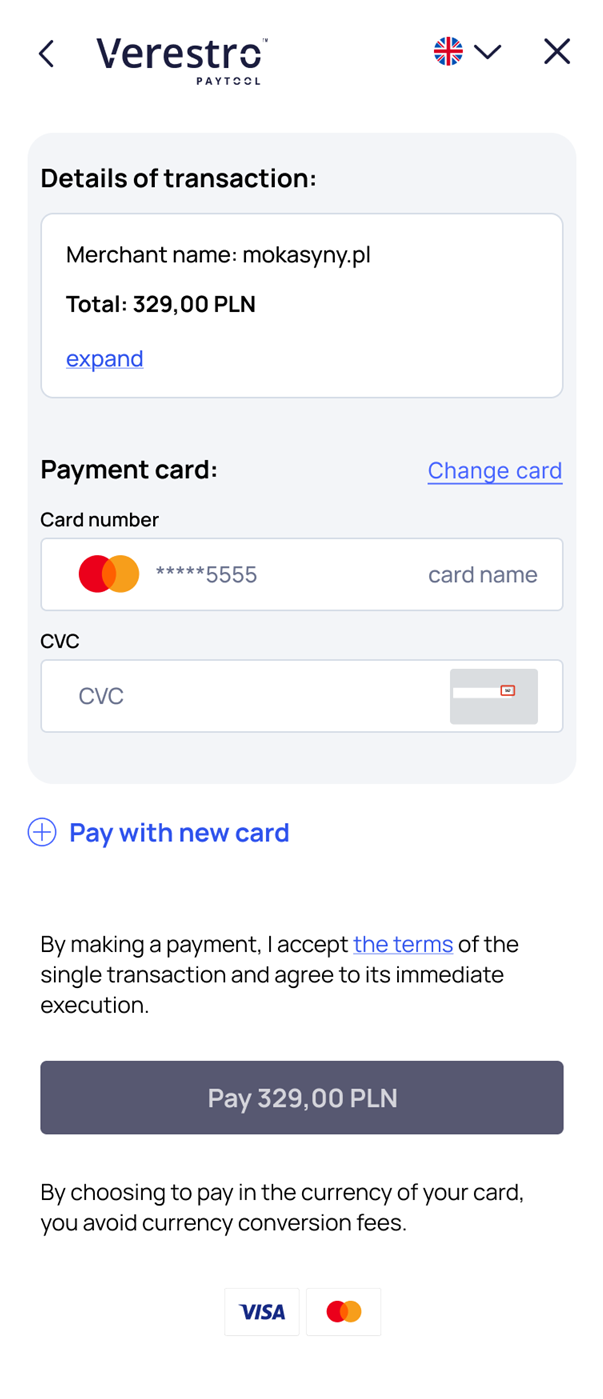](https://developer.verestro.com/uploads/images/gallery/2025-08/uIoexisting-card1.png) | If the payer has more than one saved card, they can open the list of all their saved cards to choose a card other than the default one for the transaction. From the card selection view, it is also possible to: - add a new card, - edit existing cards. In the edit mode, the user can: - set a different card as the default, - remove a card from the wallet. It is not possible to edit sensitive data such as the card number or expiration date. [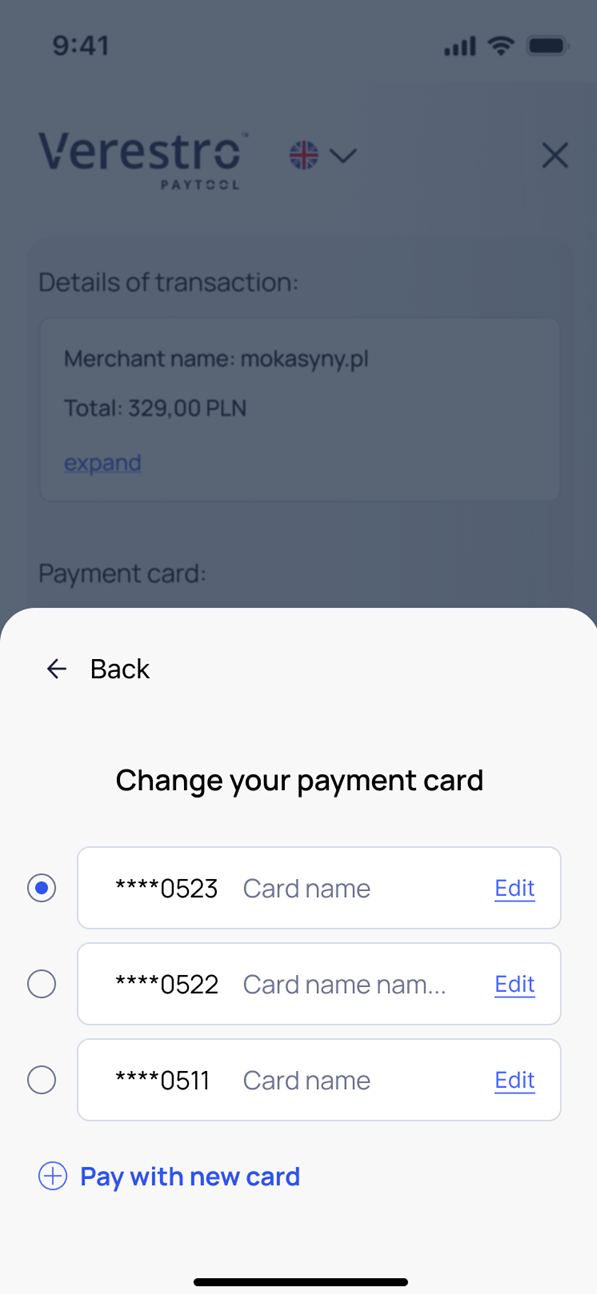](https://developer.verestro.com/uploads/images/gallery/2025-08/edit-card11.png) |
**Note:** Currently, DCC functionality is only available for transactions made with Fenige's terminal. *Fenige is our partner acquiring institution.*
After entering the card data in the correct field, the currency of the card is determined. If the dynamic currency conversion has been triggered, the following popup will be displayed to the payer and the total amount in the transaction details will be updated:| [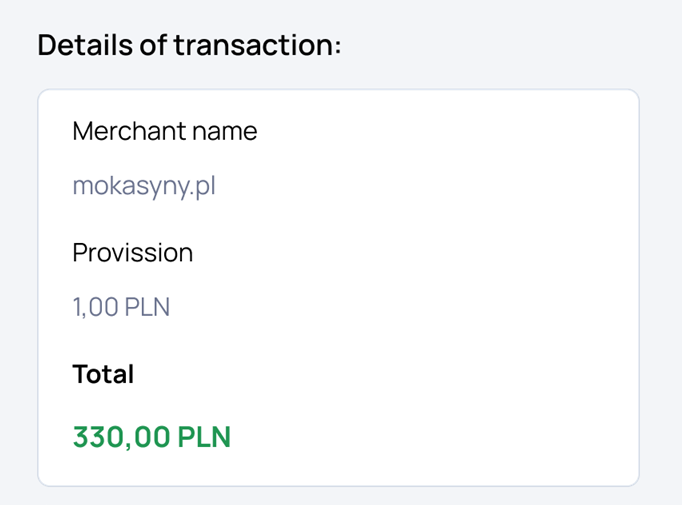](https://developer.verestro.com/uploads/images/gallery/2025-02/dcc-caluculate-2-cutted.png) | [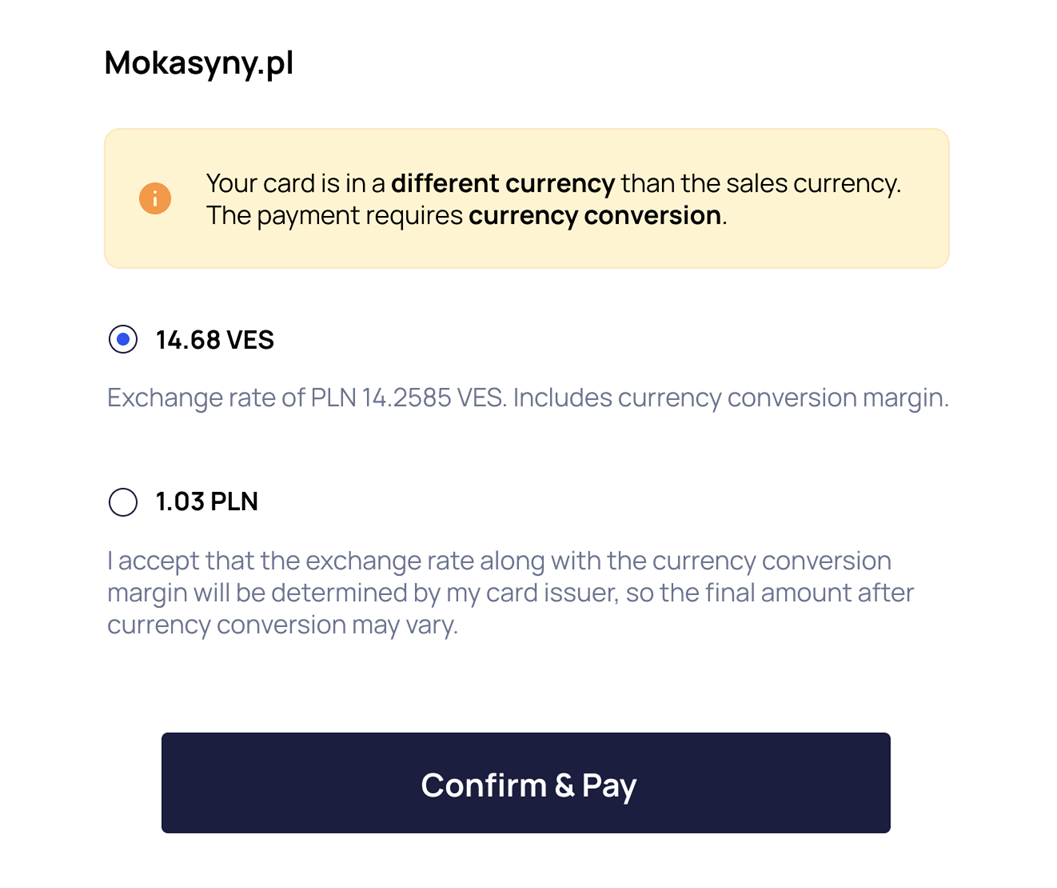](https://developer.verestro.com/uploads/images/gallery/2025-02/lFRdcc-screen.png) |
**Important:** If you use Paytool with [Payment process via API](https://developer.verestro.com/books/paytool/page/overview#bkmrk-payment-process-via-) integration path, make sure you are a registered merchant in the Google Pay™ system. This does not apply to Customers using the [Redirect your payer](https://developer.verestro.com/books/paytool/page/overview#bkmrk-redirect-your-payer) route.
**Note:** Google Pay™ provides a [Google Pay Web integration checklist](https://developers.google.com/pay/api/web/guides/test-and-deploy/integration-checklist) that will help you with the integration step by step. The documentation is available after whitelisting in Google Pay™ system. The whitelisting process is performed by Google Pay™ during the Customer's merchant account registration process.
**Note:** Google Pay™ provides [Google Pay Web Brand Guidelines](https://developers.google.com/pay/api/web/guides/brand-guidelines) that presents branding requirements for web merchants registered in Google Pay™. You must meet these requirements so that you can allow his payers to pay via the Google Pay™ solution.
### Apple Pay Verestro as a PSP registered in the Apple Pay™ allows to perform a payment with card token generated by Apple. Using our application your payer can choose the Apple Pay™ as the payment method from the Paytool payment methods list.**Tip:** Please note that as a third-party iOS application, you are allowed to use Apple Pay only for the sale of physical goods. The sale of digital goods with external payment system providers such as Paytool is prohibited by Apple. To enable the sale of digital goods using Apple Pay, you must follow Apple requirements listed [here](https://developer.verestro.com/books/enabling-apple-pay-for-selling-digital-products).
The option to pay with Apple Pay™ card token is available at the button shown below: [](https://developer.verestro.com/uploads/images/gallery/2023-11/image-1699524383207.png)**Warning!** Apple Pay payment method is available in Safari web browser only.
After clicking on the Apple Pay™ payment option, the Apple Pay™ Wallet popup is displayed. End user should select the appropriate card from the Apple Pay™ Wallet popup which is then encrypted on the Apple Pay™ side and transferred to our application. We decrypt obtained data and transfer them to the Acquirer in the transaction request. At this moment [threeDs authentication](https://developer.verestro.com/books/paytool/page/use-cases#bkmrk-threeds) process may be required. The payment process using Apple Pay™ card payment token from the end user's perpective has been shown below: [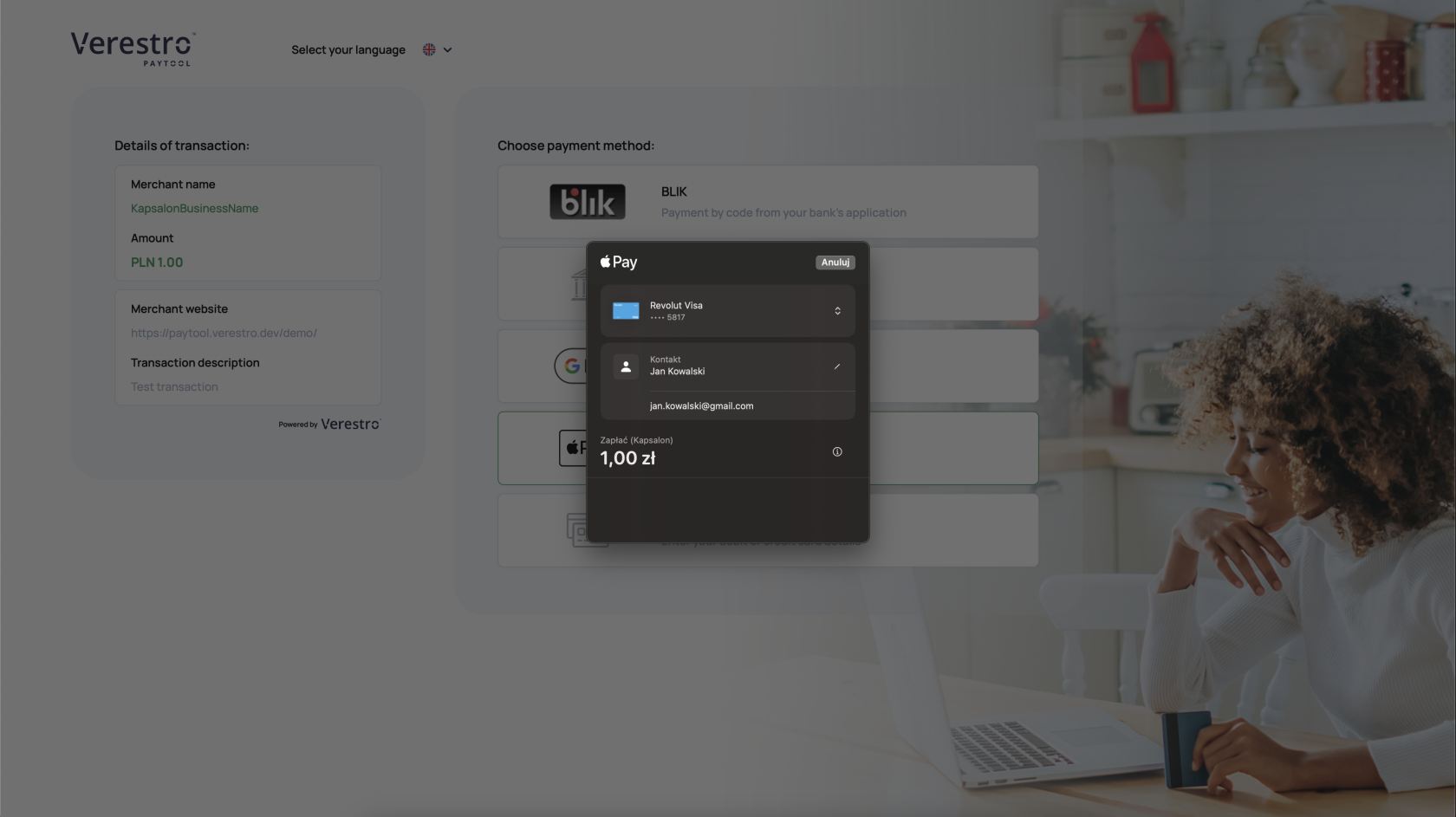](https://developer.verestro.com/uploads/images/gallery/2023-11/image-1699526152020-18-03.png)**Note:** At this moment Apple Pay biometric authorization may be required.
**Note:** Payment using the Apple Pay Wallet is only possible if the payer uses MacOS.
#### Apple Pay payment via API**Warning!** Implementation of Apple Pay backend to backend oriented is work in progress...
Alternatively Verestro allows you to perform a payment with Apple Pay card token by calling directly our API method. This is a backend to backend oriented solution. In this payment model you must be registered merchant in Apple Pay™ to be able to get a card payment token from Apple Pay™.**Important:** If you use Paytool with [Payment process via API](https://developer.verestro.com/books/paytool/page/overview#bkmrk-payment-process-via-) integration path, make sure you are a registered merchant in the Apple Pay™ system. This does not apply to Customers using the [Redirect your payer](https://developer.verestro.com/books/paytool/page/overview#bkmrk-redirect-your-payer) route.
**Note:** Apple Pay provides a complete integration guide that outlines all the steps required to register as a merchant in its system. This registration enables the merchant to launch the Apple Pay wallet directly within your own application. To do so check [Apple Pay Merchant Registration Guide](https://developer.apple.com/apple-pay/Apple-Pay-Merchant-Integration-Guide.pdf).
### Blik Our solution supports cardless payments using the Blik code. The end user can choose the Blik as the payment method from the Verestro Paytool payment methods list. The option to pay with Blik code is available at the button shown below: [](https://developer.verestro.com/uploads/images/gallery/2023-05/image-1685523665104.png)After selecting this payment method, the end user must provide his e-mail address in the proper field in displayed popup and then confirm the willingness to make the transaction. Blik as an external service, in response opens a view that allows end user to enter the 6 digits code. This step of the process takes place outside the Verestro. The 6 digits Blik code is generated in the end user's bank application. The payment process using Blik code from the end user's perpective has been shown below:| [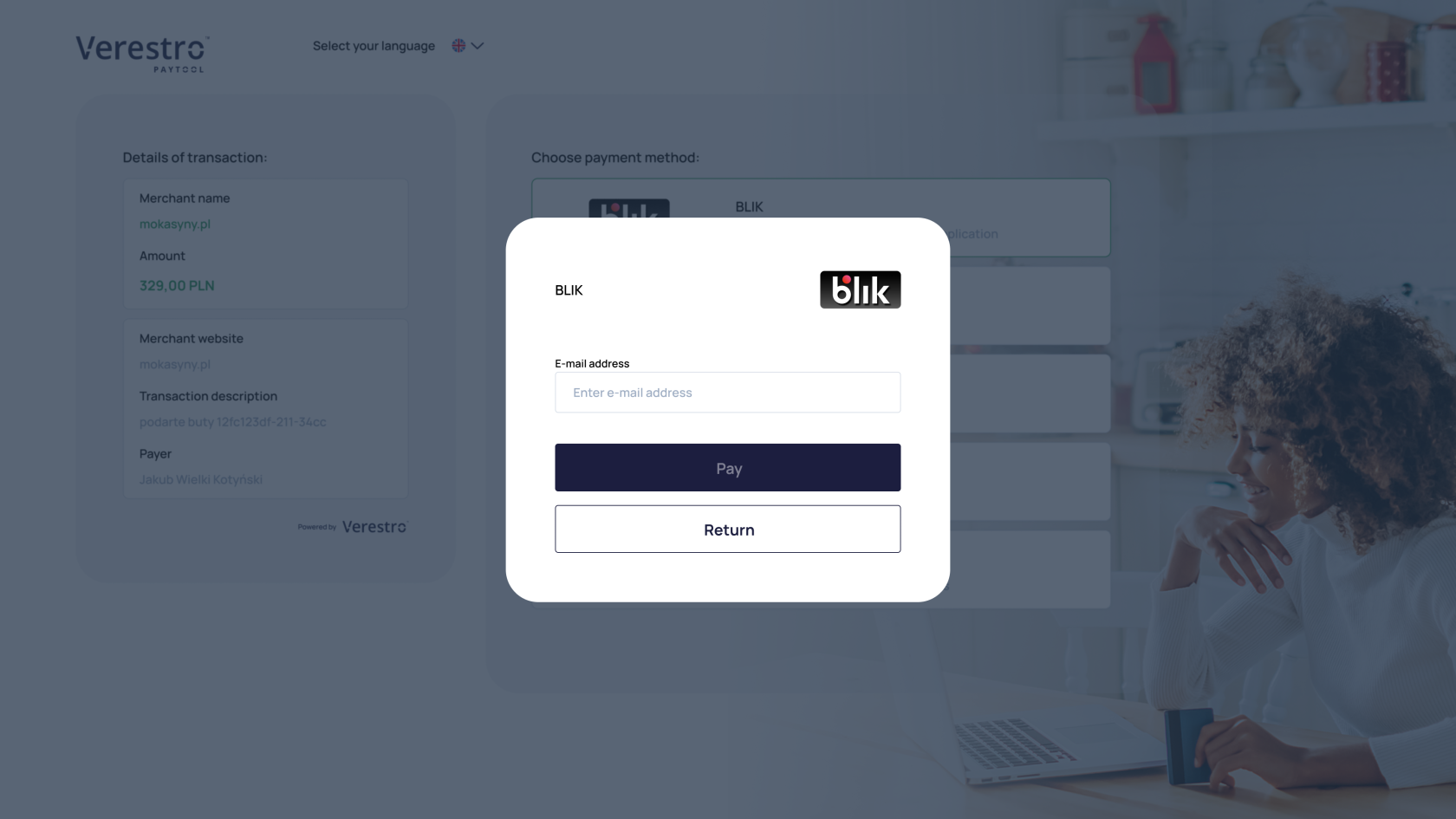](https://developer.verestro.com/uploads/images/gallery/2023-06/image-1687851945379.png) | [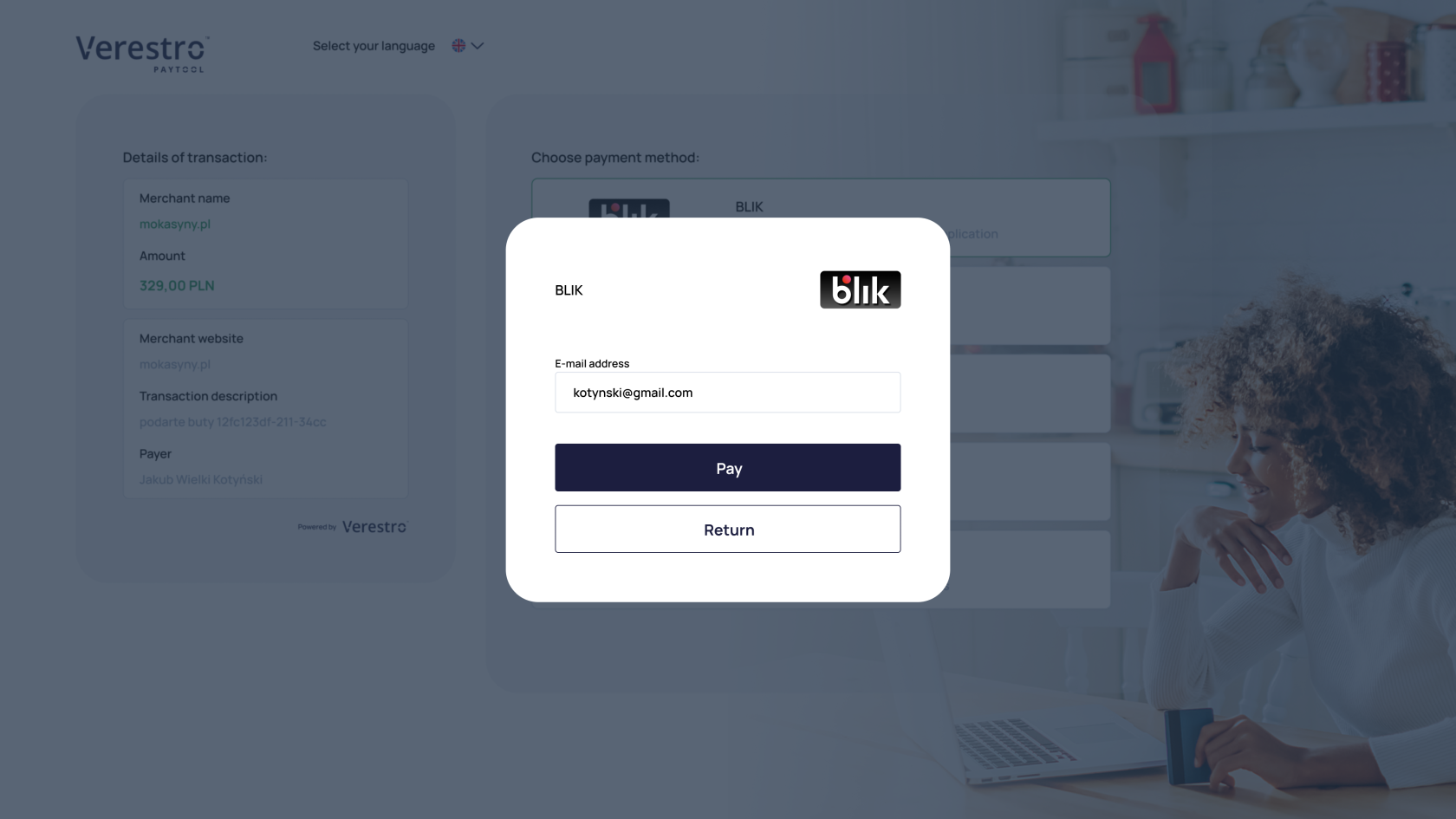](https://developer.verestro.com/uploads/images/gallery/2023-06/image-1687852047098.png) |
**Note:** ThreeDs authentication is required for card payments. This authentication method does not apply to BLIK transactions.
| ThreeDs mode | Description |
| `FRICTIONLESS` | The response containing the `FRICTIONLESS` mode denotes that payment is successfully finnished. Additional 3DS authentication is not required. |
| `CHALLENGE` | The response containing this mode denotes that the card holder must be additionally authenticated. Along with the `CHALLENGE` mode, the Bank also returns an encoded HTML template, which is displayed to the end user in the Verestro Paytool Frontend, thus allowing the end user to perform 3DS authentication. |
| [](https://developer.verestro.com/uploads/images/gallery/2023-05/image-1684330553924.png) | [](https://developer.verestro.com/uploads/images/gallery/2023-05/image-1684330621724.png) |
**Important:** In order for you to receive [notification after transaction](https://developer.verestro.com/books/paytool/page/how-to-integrate#bkmrk-transaction-postback), you must define your own endpoint. You can provide us your notification URL address during the [onboarding](https://developer.verestro.com/books/merchant-paytool/page/onboarding) process or later. We will use this notification URL address to send you post-transaction notifications.
**Note:** The appearance of the e-mail notification is configurable.
| Example e-mail notification after successful transaction | Example e-mail notification after failed transaction |
| [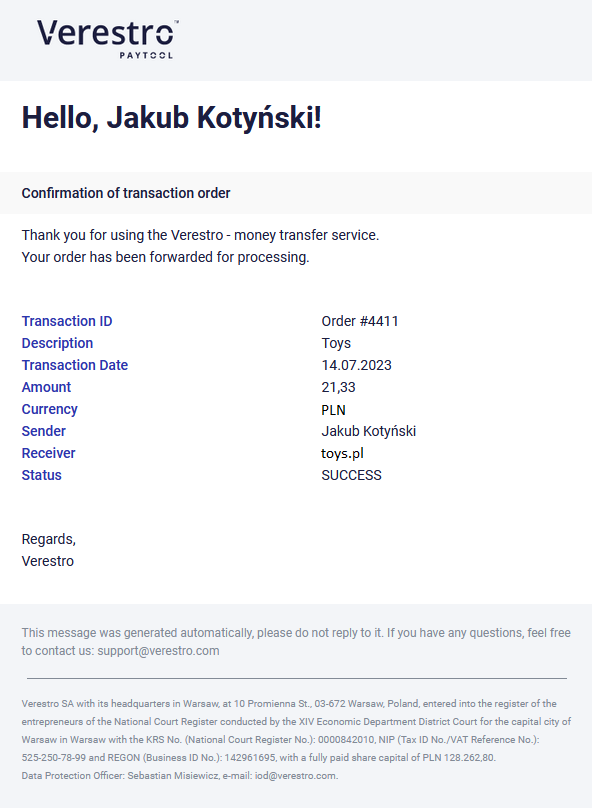](https://developer.verestro.com/uploads/images/gallery/2023-07/image-1689254790584.png) | [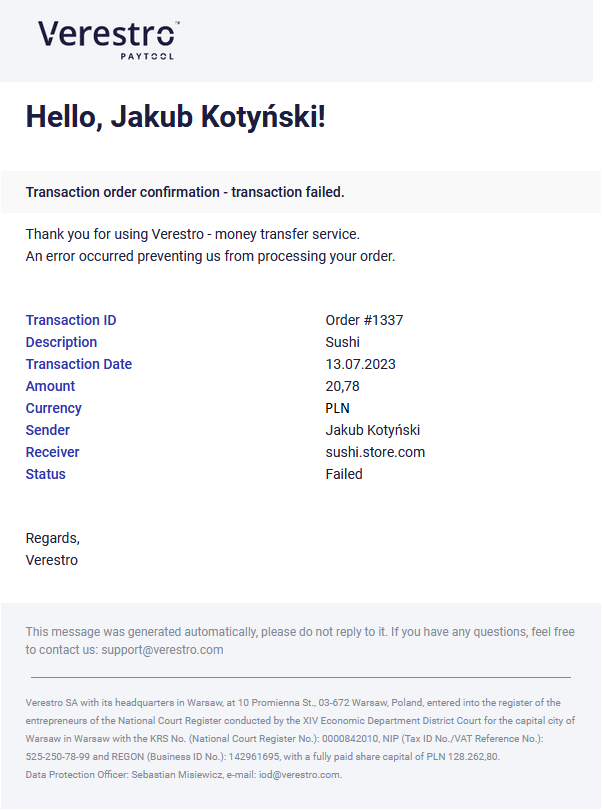](https://developer.verestro.com/uploads/images/gallery/2023-07/image-1689254800782.png) |
**Tip:** Please remember to inform us on which environment you want us to configure an account for you. Verestro Paytool offers two environments: `TEST` and `PROD`. For more information about application environments please visit [How to integrate chapter](https://developer.verestro.com/books/paytool/page/how-to-integrate).
| **To start using Paytool payment widget you need to go through a few on-boarding steps:** |
| 1\. Please contact our sales - *sales@verestro.com* |
| 2\. Please respond to some introduction question that will let us prepare proposal for you. |
| 3\. You will receive offer for eCommerce payments. |
| 4\. If you accept the offer you will be asked to provide some company documents required for the AML verification process. |
| 5\. After succesful AML process you will receive contract with our partnering acquiring institution. |
| 6\. You will be asked to provide account numbers for settlements and the data necessary to configure Paytool for you (see below) |
| 7\. And finally you will enable Paytool widget or API on your website or mobile app to enable payments. |
**Tip:** The onboarding process takes place mainly on Verestro side. However, in order for all possibilities offered by Verestro Paytool to be available, the you must provide some information needed to correctly configure your merchant account in our system.
Please provide the following information:| **Configuration parameter** | **Description** |
| Customer name | Basically, it's the name of the your company. The following parameter will be displayed to the end user in Verestro Paytool form. |
| Customer website URL | Basically, it's the website URL of the your online application. The following parameter will be displayed to the end user in Verestro Paytool form. Such addresses are required to be added to our whitelist. |
| Transaction session life time | The time given in seconds after which the initialization of the transaction will expire and processing of the payment in its context will no more be possible. |
| Redirect URL's | Those are the addresses to which end user will be redirected after a successful or unsuccessful transaction performed in Verestro Paytool. These parameters can be static (added to the your merchant account configuration) or sent in the order initiating the transaction. |
| Postback URL | Using this address we will send you information about the transaction made by a given end user. This parameter is not required if you does not want to receive notifications regarding the transaction. |
| Autodeposit property | This parameter controls whether a transactions made by merchant will be automatically deposited. This parameters can be static (added to the your merchant account configuration) or sent during the transaction initialization. |
| Supported payment methods | You should determine which of available payment methods you want to enable in Verestro Paytool. Defaultly all payment methods are enabled. This parameter can be changed anytime. Available payment methods in Paytool: Google Pay, Apple Pay, Blik, plain card number. |
| Acquirer's Merchant Id (MID) | It is an identifier of your account in the Acquirer system. This parameter is obligatory to perform transaction. If your company supports more then 1 MID, please let us know which one should be treat as default one.
**Note: **Default MID will be selected if you will not provide any of your MIDs in the transaction initialization request. **Tip: **We are suggesting to use [Acquirer Fenige](https://www.fenige.com/). Fenige is our partner acquiring institution and we are fully integrated with this Acquirer |
| Acquirer credentials | Login and password that should be used to authorize your payment in the system of a given Acquirer in the context of a given terminal. |
| (Optional) Customer's logo and/or picture | These are image that could be, for example, your company logo. They will be posted as requested in the Verestro Paytool webview. This point is optional. If you do not provide such pictures, the Verestro Paytool will be shown with it's default appearance. Send this in `.SVG` format. |
**Important!** If you require transactions to be processed with the participation of a Acquirer to which Verestro is not integrated, then there must be performed a new integration. You should provide the given Acquirer API documentation that Verestro will use during the integration.
#### Returned data After creating an account for the Customer, Verestro returns all necessary data which allow to use the solution. Such data includes:| **Configuration parameter** | **Description** |
| Certificate X509 | |
| Gateway Id | This is a constant and unique value that defines the PSP in the Google Pay™ system. When making a call to get a card token, the Customer transfers this value to Google Pay™ in the request. Verestro is defined by Gateway Id with `verestro` value.
**Note:** This only applies to Customers who make Google Pay payments by connecting directly to the Paytool API. Customers redirecting their payers to the Paytool frontend form should ignore this information. |
| Gateway Merchant Id | This is a unique Customer identifier assigned by Verestro during the onboarding process. This identifier is in the form of a `UUID`. Verestro understands and uses this to verify that the message was for the Customer that made the request. Customer passes it to Google Pay™. More information about the Gateway Merchant Id can be found in [Google Pay™ documentation.](https://developers.google.com/pay/api/processors/guides/implementation/understand-our-payload)
**Note:** This only applies to Customers who make Google Pay payments by connecting directly to the Paytool API. Customers redirecting their payers to the Paytool frontend form should ignore this information. |
**Note:** This only applies to Customers who make Google Pay payments by connecting directly to the [Paytool API](https://developer.verestro.com/books/paytool/page/overview#bkmrk-payment-process-via-). If you are using [Redirect your payer](https://developer.verestro.com/books/paytool/page/overview#bkmrk-redirect-your-payer) integration path you can ignore this section.
If you use Paytool with [Payment process via API](https://developer.verestro.com/books/paytool/page/overview#bkmrk-payment-process-via-) integration path, make sure you are a registered merchant in the Google Pay™ system. This does not apply to Customers using the [Redirect your payer](https://developer.verestro.com/books/paytool/page/overview#bkmrk-redirect-your-payer) route. To use the Token Payment Service solution, it is necessary for the Customer (you) to be registered as merchant in the Google Pay™ system. As an unregistered Customer you will not be able to get the card payment token from Google Pay in your application. To register in Google Pay™ visit [Google Pay for Business quick start guide](https://support.google.com/pay/business/topic/7684388?hl=en&ref_topic=7513501) or contact Google Pay™ support. After completing registration as a merchant, the Customer will receive an access to Google Pay™ documentation enabling technical integration.| [Google Pay Web integration checklist](https://developers.google.com/pay/api/web/guides/test-and-deploy/integration-checklist) | A checklist presenting the Google Pay integration requirements that must be met by the Customer integrating web application |
| [Google Pay Web developer documentation](https://developers.google.com/pay/api/web) | Technical documentation describing web integration with the Google Pay solution |
| [Google Pay Web Brand Guidelines](https://developers.google.com/pay/api/web/guides/brand-guidelines) | Branding requirements that must be met by the Customer's web application to be able to use the Google Pay solution |
**Note:** This only applies to Customers who make Apple Pay payments by connecting directly to the [Paytool API](https://developer.verestro.com/books/paytool/page/overview#bkmrk-payment-process-via-). If you are using [Redirect your payer](https://developer.verestro.com/books/paytool/page/overview#bkmrk-redirect-your-payer) integration path you can ignore this section.
If you use Paytool with [Payment process via API](https://developer.verestro.com/books/paytool/page/overview#bkmrk-payment-process-via-) integration path, make sure you are a registered merchant in the Apple Pay™ system. This does not apply to Customers using the [Redirect your payer](https://developer.verestro.com/books/paytool/page/overview#bkmrk-redirect-your-payer) route. To use the Token Payment Service solution, it is necessary for the Customer (you) to be registered as merchant in the Google Pay™ system. As an unregistered Customer you will not be able to get the card payment token from Apple Pay in your application. To register in Apple Pay™ follow [Apple Pay Merchant Integration Guide](https://developer.apple.com/apple-pay/Apple-Pay-Merchant-Integration-Guide.pdf).**Note:** To create an account in the Verestro Paytool system please contact with support.
**Tip:** Below are presented sequence diagrams describing both ways of using the Paytool solution. We recommend using **Redirect you payer** integration path.
**Tip:** Below there is a description of every single Paytool API method. To see example request bodies please visit complete API documentation is [available here](https://developer.verestro.com/books/paytool/page/paytool-external-api) in SwaggerUI format. Please visit to see our methods.
**Tip:** Detailed information about what is included in the transaction metadata is shown in the `transactionInitialization` method.
[Opening Paytool in iframe](https://paytool.verestro.com/docs/) This section describes the steps you need to take if you want the Paytool form to be displayed as an iframe on your website instead of redirecting your payer to Verestro Paytool website.**Tip:** This section applies to customers who use the Redirect your payer implementation model. If you use a different integration model with Paytool, you can ignore this chapter.
# Test Guide**Tip:** Check it now. Verestro Paytool demo application is available [here.](https://paytool.verestro.dev/demo/)
## Plain card number This method involves processing payments using credit or debit cards. In order to test it you will need to generate test cards because of possibility of getting card blocked due to anti-fraud policies on the acquirer side. Payment with plain card number use case is described [here](https://developer.verestro.com/books/paytool/page/use-cases#bkmrk-plain-card-number). ### Test cards| Card type | Card BIN |
| VISA | 511796XXXXXXXXXX |
| Mastercard | 545313XXXXXXXXXX |
**Note:** CVV may be randomized, expiration date must not be expired.
### Testing various transaction paths| ThreeDs mode | Amount |
| [`FRICTIONLESS`](https://developer.verestro.com/books/paytool/page/use-cases#bkmrk-%40startumlskinparam-p-2) | 100 - 1000 |
| [`CHALLENGE`](https://developer.verestro.com/books/paytool/page/use-cases#bkmrk-challenge) | 1001 - 3000 |
**Note:** Amount is a value determining amount of cash transferred in one hundredth of the currency \[1,00 USD = 100\].
**Tip:** Select an amount between 3001-8000 to test failed transaction.
## Google Pay**Note:** To be able to test all flows of ThreeDs in Google Pay follow the description about [testing various transaction paths](https://developer.verestro.com/books/paytool/page/test-guide#:~:text=an%20expired%20date.-,Testing%20various%20transaction%20paths,-As%20described%20in)
## Apple Pay This method involves processing payments using tokenized credit or debit cards. You need to create Apple sandbox tester account. Follow [apple documentation](https://developer.apple.com/apple-pay/sandbox-testing/#:~:text=supports%20TLS%C2%A01.2.-,Create%20a%20Sandbox%20Tester%20Account,-To%20create%20a) to do so. After registration and logging in into tester account you are ready to test Apple Pay token payment. There is a list of [apple-pay valid payment cards.](https://developer.apple.com/apple-pay/sandbox-testing/#:~:text=Test%20Cards%20for%20Apps%20and%20the%20Web) Payment with Apple Pay use case is described [here](https://developer.verestro.com/books/paytool/page/use-cases#bkmrk-apple-pay). ## Blik**Important!** Implemenation is work in progress...
# Quick start sandbox in your app**Info:** Remember that this is a sandbox version. This means that the transaction is a test. No fees will be charged for executing payment.
#### The required steps for setting up a Paytool sandbox in your application| 1\. Call Paytool API by executing transaction initialization method. You can use the cURL below to do it. |
| ```json curl --location 'https://paytool-api.verestro.dev/external-api/transactions' \ --header 'Content-Type: application/json' \ --header 'Authorization: Basic bWVyY2hhbnRfcGF5dG9vbF9kZW1vOmthcHNhbG9uUGFzcw==' \ --data-raw '{ "amount": 100, "autoDeposit": true, "currencyCode": "PLN", "description": "Test transaction", "merchantUrl": "https://paytool.verestro.dev/demo/", "redirectUrl": { "successUrl": "https://paytool.verestro.dev/demo/", "failureUrl": "https://paytool.verestro.dev/demo/" }, "sender": { "firstName": "John", "lastName": "Doe", "email": "testjohn@gmail.com", "address": { "countryCode": "PL", "city": "Warszawa", "postalCode": "03-672", "street": "Promienna", "houseNumber": "10" } } }' ``` |
| 2. In the response to the cURL call, we will return the `transactionId` and the URL to which you should redirect the payer. This URL address will open the Paytool view shown below: |
| [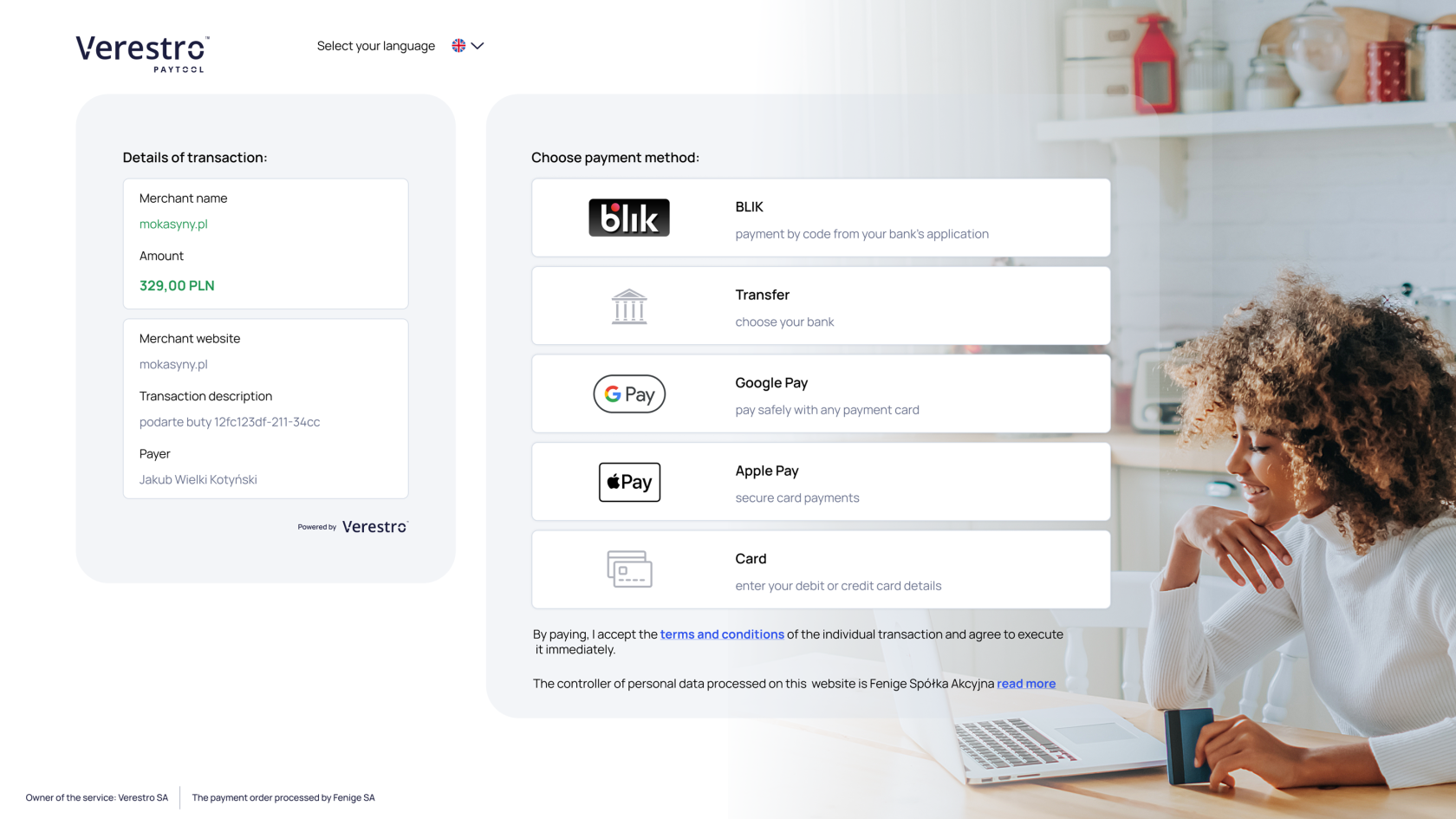](https://developer.verestro.com/uploads/images/gallery/2025-05/paytool-main-view-po.png) |
**Info:** The authentication in our system is handled through the mTLS. To get a certificate please [visit this link.](https://developer.verestro.com/books/connecting-to-our-services-and-sandbox/page/connecting-to-server-to-server-apis-fe-sandbox#bkmrk-for-beta%2Fproduction-0)
##### How to get certificate x509 Generate a key pair: ``` openssl genrsa -out client.key 2048 ``` Create a Certificate Signing Request (CSR): ``` openssl req -new -newkey rsa:4096 -keyout companyName.key -out companyName.csr -nodes -subj '/C=US/ST=Florida/L=Miami/O=SomeCompany/OU=main/CN=V-customer-App/emailAddress=example@user.com' ``` Send the `.csr` file to our Chief of the security department: *sebastian.misiewicz@verestro.com* @swagger="[https://paytool-api.verestro.com/doc/external.yaml"](https://iban-management.upaid.pl/doc/server.yaml)